Why do wildebeest migrate? This natural phenomenon is one of the most fascinating and significant events in the animal kingdom. The annual migration of over 1.5 million wildebeest, accompanied by hundreds of thousands of zebras and gazelles, is a spectacular journey that spans across the vast plains of the Serengeti in Tanzania and the Masai Mara in Kenya.
This migration is not just a journey; it’s a survival strategy that has evolved over millennia, driven by the need for food, water, and safe calving grounds.
Understanding the reasons behind this migration can offer deeper insights into the delicate balance of the ecosystem and the incredible endurance of these animals.
What is the Wildebeest Migration?
The wildebeest migration is a continuous, circular journey that takes place between the Serengeti in Tanzania and the Masai Mara in Kenya. This annual migration, often referred to as the Great Migration, is one of the most impressive wildlife spectacles on Earth. The migration is driven by the search for fresh grazing and water, essential for the survival of the wildebeest and other herbivores.
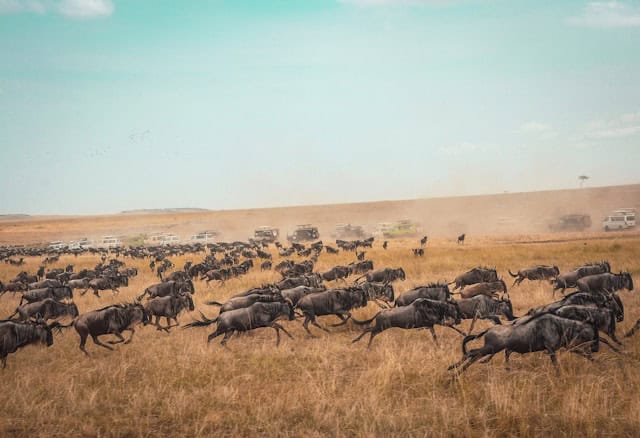
The migration follows a roughly predictable pattern, influenced by seasonal rainfall and the availability of grass. Starting in the southern Serengeti, wildebeest give birth to calves between January and March, taking advantage of the nutrient-rich short grasses. As the dry season sets in, the herds move northwest towards the Grumeti River, where they face one of their first major challenges: crossing crocodile-infested waters.
By July, the herds reach the northern Serengeti and prepare for the dramatic crossings of the Mara River into Kenya’s Masai Mara. These crossings are riddled with danger, but they are crucial for reaching the lush grazing lands on the other side.
After spending a few months in the Masai Mara, the wildebeest begin their southward journey back to the Serengeti, completing the cycle.
The Science Behind the Wildebeest Migration
The wildebeest migration is a complex ecological phenomenon driven by several scientific factors. Primarily, it is influenced by the availability of fresh grazing and water, which are dictated by the region’s seasonal rainfall patterns. Wildebeest, zebras, and gazelles migrate in search of nutrient-rich grasses that sprout just after the rains.
Role of Rainfall and Grass Growth

Rainfall plays a pivotal role in the migration. The wildebeest follow the rains in a cyclical pattern, moving to areas where the grass is green and water is plentiful. This ensures that they have access to the essential nutrients needed for their survival and reproduction.
Studies have shown that wildebeest can cover distances of up to 1,000 miles annually.
Nutrient Cycling and Ecosystem Benefits
The migration also has significant ecological benefits. As wildebeest graze, they stimulate grass growth, which helps maintain the savanna ecosystem. Their movement aids in nutrient cycling, as their droppings fertilize the soil, promoting a healthy and balanced environment.
Furthermore, the migration supports a diverse range of predators, including lions, cheetahs, and hyenas, which rely on the wildebeest for food.
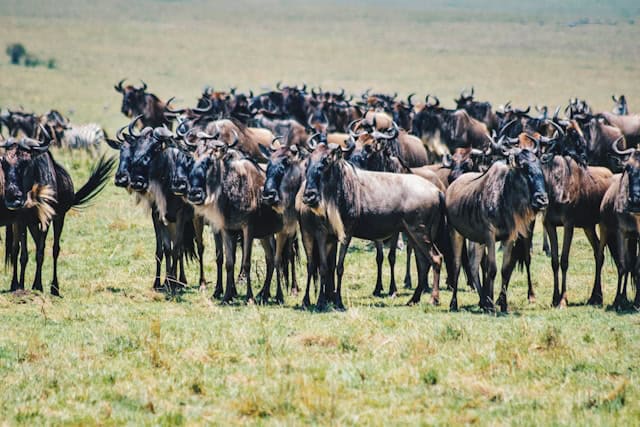
According to research, over 1.5 million wildebeest, along with hundreds of thousands of zebras and gazelles, participate in this migration each year. This vast movement of animals is not only crucial for their survival but also for maintaining the ecological integrity of the Serengeti and Masai Mara ecosystems.
Survival Strategies During the Wildebeest Migration
The wildebeest migration is dangerous and survival requires a combination of strategies. The primary threats come from predators, harsh environmental conditions, and the physical demands of the journey. Wildebeest have developed several survival tactics to navigate these challenges successfully.
Predator-Prey Dynamics
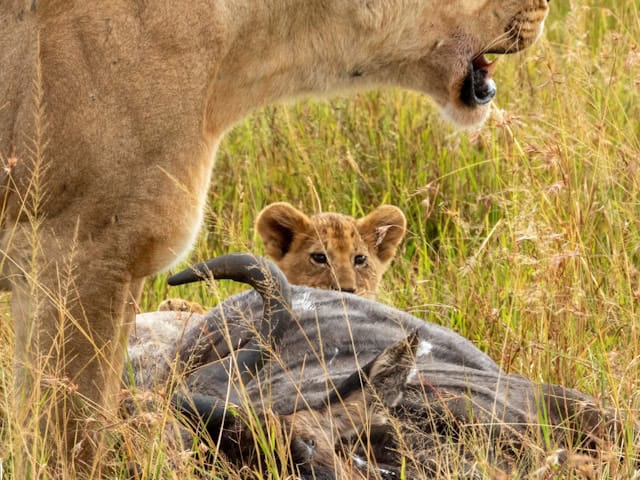
During the migration, wildebeest face constant threats from predators such as lions, cheetahs, hyenas, and crocodiles. These predators often target the young, weak, or isolated individuals. To mitigate this risk, wildebeest rely on the safety of numbers. Moving in large herds reduces the likelihood of any single individual being caught.
Additionally, the synchronized calving period in the southern Serengeti results in thousands of calves being born within a short timeframe. This “predator swamping” strategy overwhelms predators, ensuring that a significant number of calves survive.
Herd Behavior
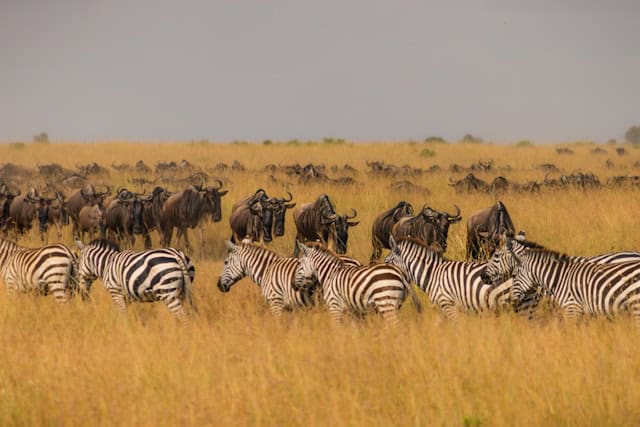
Wildebeest exhibit strong herd behavior, which is crucial for their survival during migration. The herd’s movement is not random but highly coordinated, with leaders guiding the direction based on environmental cues.
This coordinated movement helps them efficiently find new grazing areas and water sources. The constant motion and large numbers also make it difficult for predators to single out an individual.
Furthermore, wildebeest communicate through vocalizations and visual signals to maintain herd cohesion and respond to threats quickly.
Calving and Young Survival Rates
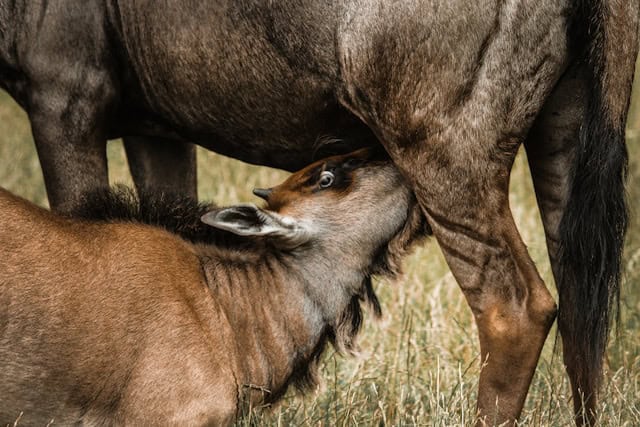
The calving season in the southern Serengeti is a critical period for wildebeest. By timing births to coincide with the abundance of fresh grass, wildebeest ensure that the mothers have sufficient nutrition to produce milk, enhancing calf survival rates.
Calves are born with the ability to stand and run within minutes, a vital adaptation for escaping predators. The survival rate of calves is also increased by the presence of other species, such as zebras and gazelles, which add to the herd’s overall vigilance and defense.
Studies indicate that predator attacks during migration can result in a mortality rate of up to 6% annually. Despite this, the strategies wildebeest adopt help to ensure that a large proportion of the population survives and thrives, sustaining the migration cycle year after year.
Key Stages of the Wildebeest Migration
The wildebeest migration happens in stages throughout the year. Each stage has its own challenges and highlights, making the journey a fascinating event to witness.
Calving Season in the Southern Serengeti

From January to March, the southern Serengeti becomes a nursery as wildebeest give birth to their calves. This period is crucial because it ensures the young have enough food and a safe environment to grow.
Over 500,000 calves are born during this time, creating a spectacle of new life. The abundance of grass in the southern Serengeti provides the nutrition needed for the mothers and their newborns.
River Crossings in the Masai Mara
One of the most dramatic stages of the migration is the river crossings, especially at the Mara River in Kenya.
Between July and October, the herds face the challenge of crossing these rivers, which are filled with hungry crocodiles. The crossings are risky, and many wildebeest do not make it.
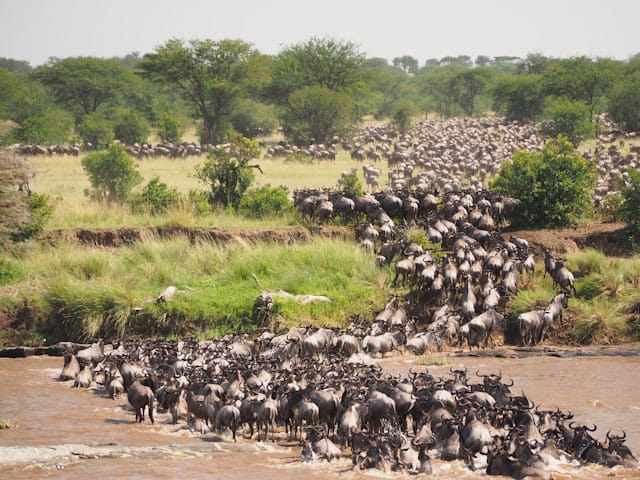
However, those that do are rewarded with lush grazing lands in the Masai Mara. These crossings are a highlight for many tourists, offering thrilling and unforgettable scenes.
Return Journey and Grazing Cycles
After spending time in the Masai Mara, the herds begin their journey back to the Serengeti around October. They move south, following the rains and the fresh grass that grows in response. By December, they return to the southern Serengeti, completing the cycle. This continuous movement ensures that the wildebeest have access to the best grazing areas throughout the year.
The timing and success of each stage depend heavily on the weather and availability of resources. Understanding these key stages helps us appreciate the resilience and adaptability of the wildebeest during their incredible journey.
Impact of Wildebeest Migration on the Ecosystem
The wildebeest migration has a profound impact on the ecosystems of the Serengeti and Masai Mara. This annual event supports a wide range of plant and animal species, contributing to the health and balance of these environments.
Benefits to Other Species
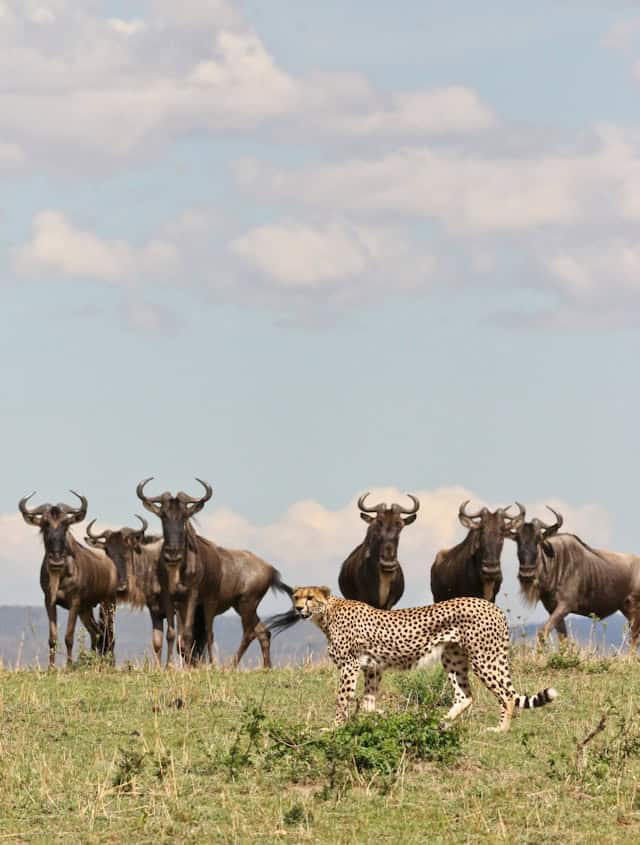
As the wildebeest migrate, they leave behind nutrient-rich droppings that fertilize the soil. This natural fertilization process promotes the growth of grasses and other vegetation, which in turn supports herbivores like zebras, gazelles, and antelopes. The presence of these herbivores attracts predators such as lions, cheetahs, and hyenas, creating a thriving and dynamic food web.
Changes in Vegetation Patterns
The constant movement of large herds of wildebeest helps to prevent overgrazing in any one area. By moving from one region to another, the herds allow grasses to recover and regenerate, maintaining the health of the savanna. This grazing pattern ensures that the landscape remains productive and capable of supporting diverse wildlife.
Role in Nutrient Distribution
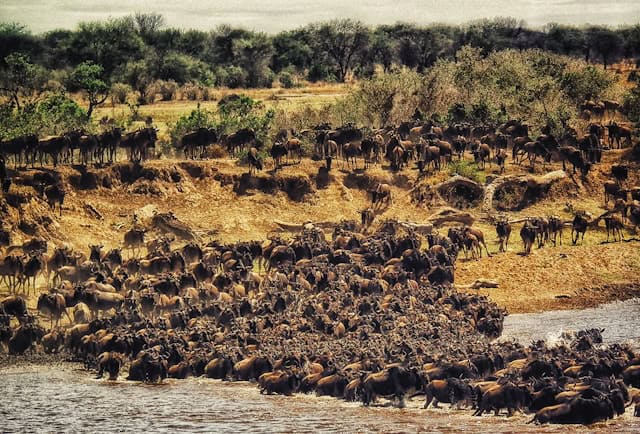
The Great Migration also plays a crucial role in nutrient distribution. As wildebeest graze and move across vast distances, they spread seeds and organic matter, enriching the soil across different regions. This process helps to sustain various plant species and maintains the overall fertility of the ecosystem.
Studies have shown that the presence of wildebeest can increase the biomass of grasslands by up to 30%, highlighting their importance in maintaining the ecological balance. The migration is not just a spectacle but a vital component of the Serengeti and Masai Mara ecosystems, supporting a wide array of life and ensuring the continued health of these iconic landscapes.
Human Influence and Conservation Efforts
Human activities have a significant impact on the wildebeest migration and the ecosystems they traverse. Tourism, development, and conservation efforts all play a role in shaping the future of this natural spectacle.
Effects of Tourism
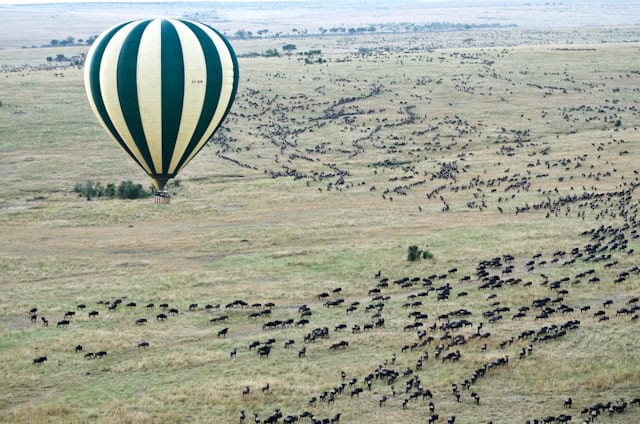
Tourism is a double-edged sword for the wildebeest migration.
On one hand, it generates substantial revenue that can be used for conservation efforts. On the other hand, increased human presence can disrupt wildlife and their natural behavior.
During peak migration periods, the influx of tourists can lead to overcrowding in key areas, potentially stressing the animals and their habitats. Responsible tourism practices, such as regulated safari routes and limited vehicle access, are essential to minimize this type of impact.
Conservation Challenges
The primary challenges to conserving the wildebeest migration include habitat loss, poaching, and climate change. Expanding human settlements and agricultural activities encroach on the migration routes, limiting the areas where wildebeest can safely graze and move.

Poaching remains a threat, particularly for species like elephants and rhinos that share the same habitats. Climate change alters rainfall patterns, which can affect the availability of water and grazing lands, disrupting the migration cycle.
Initiatives to Protect Migration Routes
Several initiatives are in place to protect the wildebeest migration and ensure its continuity.
Conservation organizations and governments work together to establish protected areas and wildlife corridors that facilitate safe passage for the migrating herds. Community-based conservation projects involve local communities in protecting wildlife, providing them with incentives and education on sustainable practices.
Tourism revenue also funds anti-poaching efforts and habitat restoration projects. For example, the Serengeti National Park and the Masai Mara National Reserve implement various measures to safeguard the migration routes and habitats. These include ranger patrols, community outreach programs, and scientific research to monitor and address emerging threats.
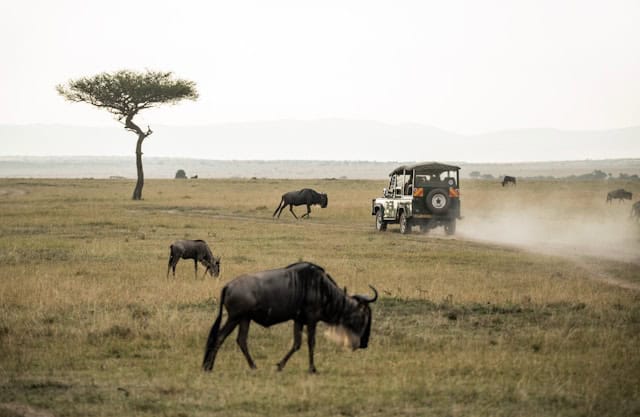
According to recent reports, tourism in the Serengeti generates approximately $500 million annually, a significant portion of which is reinvested into conservation. Such efforts are crucial to maintaining the delicate balance of the ecosystem and ensuring that the wildebeest migration remains one of the world’s most awe-inspiring natural events.
Best Times and Places to Witness the Wildebeest Migration
The wildebeest migration is a year-round event, but certain times and locations offer the best viewing opportunities. Knowing when and where to go can enhance your experience of this natural wonder.
Peak Viewing Periods
The migration follows a predictable pattern, with specific times of the year being ideal for witnessing different stages of the journey. From January to March, the southern Serengeti is the place to be. This is the calving season, where over 500,000 wildebeest calves are born. The abundance of newborns attracts predators, making it an exciting time for wildlife enthusiasts.
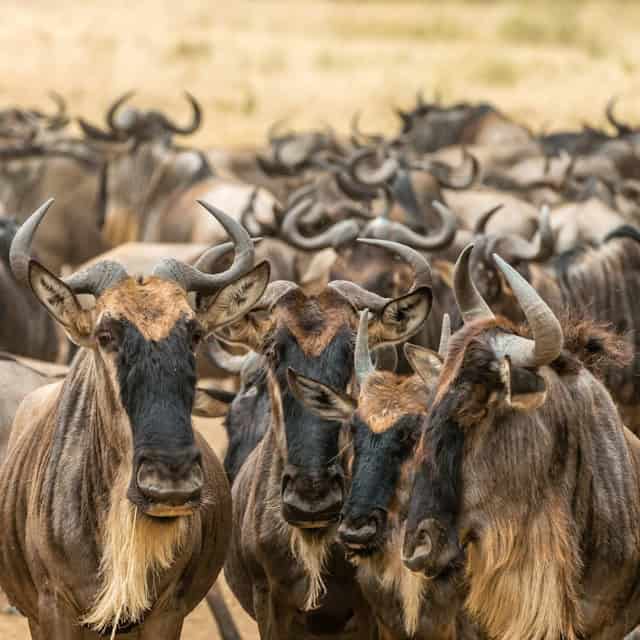
Between July and October, the herds make their way to the Masai Mara in Kenya. This period is famous for the dramatic river crossings at the Mara and Talek Rivers. Watching thousands of wildebeest brave the crocodile-infested waters is a highlight for many visitors.
From November to December, the wildebeest begin their southward journey back to the Serengeti. The herds can be seen moving through the central and eastern Serengeti, providing excellent viewing opportunities.
Recommended Reading: 💎 African Safari Planners: How to Plan Luxury Safaris
Recommended Safari Locations
Different locations offer unique perspectives on the migration.
In the Serengeti, the Ndutu region in the south is ideal during the calving season. For the river crossings, the western Serengeti and northern Serengeti are prime spots. In the Masai Mara, the Mara Triangle and the Talek River area are excellent places to witness the migration during the peak season.
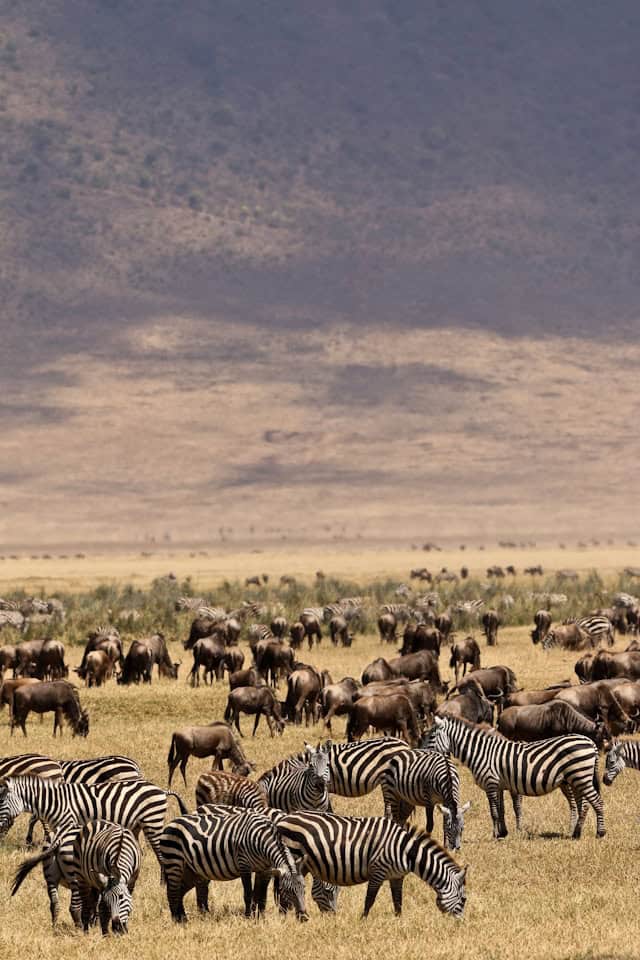
Private conservancies around the Masai Mara offer more exclusive and intimate viewing experiences. These conservancies limit the number of visitors, allowing for less crowded and more personalized safaris.
Recommended Reading: 📝 How to Plan a Tanzania Budget Safari (Tours & Parks)
Tips for Planning a Visit
To make the most of your wildebeest migration safari, consider the following tips:
- Book Early: Accommodations and safari tours can fill up quickly, especially during peak seasons. Booking well in advance ensures you get the best options.
- Choose the Right Time: Align your visit with the specific stage of the migration you are most interested in. Each period offers different experiences, from calving to river crossings.
- Hire Experienced Guides: Knowledgeable guides can enhance your safari by providing insights into animal behavior and the migration’s ecological significance.
- Stay in Multiple Locations: To get a comprehensive view of the migration, consider staying in different parts of the Serengeti and Masai Mara.
According to recent statistics, over 250,000 tourists visit the Serengeti and Masai Mara each year to witness the migration. With careful planning, you can be among those who experience this extraordinary event up close.

Recommended Reading: 👨👩👧👦 Family Safari in Kenya | Best Tours and Packages
Conclusion
The wildebeest migration is one of nature’s most remarkable spectacles. Each year, over 1.5 million wildebeest, along with hundreds of thousands of zebras and gazelles, set out on a journey driven by the search for fresh grazing and water. This migration plays a crucial role in maintaining the ecological balance of the Serengeti and Masai Mara ecosystems.
Understanding why wildebeest migrate reveals the intricate relationship between these animals and their environment. From the challenges they face to the benefits they bring to other species and the land, the migration is a testament to the resilience and adaptability of wildlife.
Whether you witness the calving season in the southern Serengeti or the dramatic river crossings in the Masai Mara, the wildebeest migration offers an unforgettable experience. It is a powerful reminder of the natural world’s beauty and the importance of conservation efforts to protect these majestic journeys for future generations.
